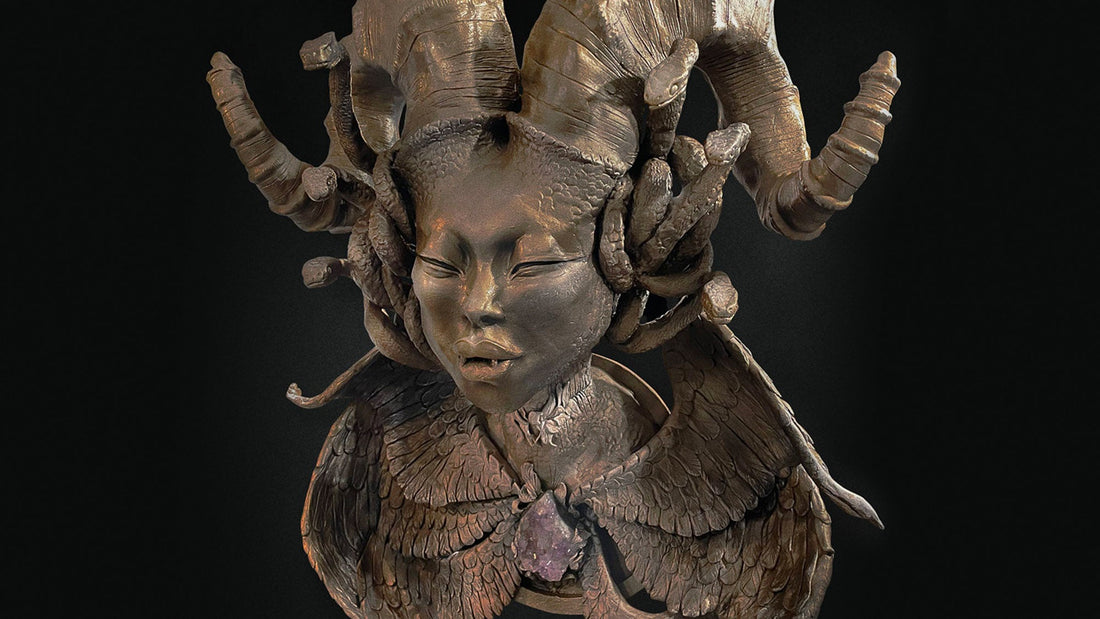
Aegis of Medusa: : Trauma, Healing, and Strength in Art and Sculpture
Share
Introduction
My latest sculpture, Aegis of Medusa, seeks to hold complexity, tell truths, and inspire healing. With six wings blooming out from a real amethyst geode at its heart, a halo of adders and giant horns framing her peaceful face, it's a large wall-hanging sculpture and a symbol of protection, transformation, and strength. Now on display at Bone Deep Piercings in Camarillo, this sculpture carries a story.
About the Sculpture
Aegis of Medusa is more than a sculpture; it’s a labor of love and a meditation on healing. This piece was constructed using a wooden base frame, wire, foil filler, and plaster for the foundational shape. I used over 16 pounds of Apoxie clay alone for her intricate details. For the textures of the adders in her serpentine hair I created a custom-made tool. Her chest is adorned with a real amethyst geode, a stone known for its protective and healing properties.
The wings, inspired by Pegasus, are sculpted to symbolize renewal and hope. With a lightweight foil base and a plaster coating, finished with Apoxie clay and Paper Clay, they were crafted to be both expansive and sturdy. After curing, I painted the entire sculpture with black gesso, layered on sprays of gold and gray Krylon paint, and sealed it with acrylic UV protectant.
Trigger Warning: Content discusses sensitive themes including sexual violence and trauma. Reader discretion is advised.
The Classic Story Behind Medusa
Medusa’s myth is as complex as it is misunderstood. In the most contemporary retelling, it goes something like this: She was one of the three Gorgon sisters, but the only mortal one. This sealed her tragic fate. In some versions of the myth, Medusa was a priestess of Athena, a goddess she served with devotion. When Poseidon pursued and assaulted her in Athena’s temple, she sought refuge, but the act of defilement enraged Athena. Instead of punishing Poseidon, Athena cursed Medusa, transforming her into a creature with snakes for hair and the power to turn men to stone.
This version of Medusa’s story portrays her as both victim and survivor, but it also showcases her strength. This is her ability to transform trauma into power. Her gaze became her shield, and her presence became a force to be reckoned with.
Reimagining Medusa’s Story
Obviously, there are so many versions of the story. In the original, there wasn’t even a mention of rape, and Pegasus was said to be born from a union of love. However, this is the version that has taken root in our modern day lexicon. So, I wanted to take the opportunity to update it. If stories with such archetypal images and emotions can evolve with the times, let us continue to reshape them.
So, let us begin: Medusa, one of three Gorgon sisters, was the only mortal. Despite her mortality, she retained the beauty of the gods and immortals and looked human. She chose a life of devotion, serving as a priestess to the goddess Athena. Poseidon, the sea god known for his unchecked desires, became infatuated with her. When she rejected him, he pursued her, forcing her to seek refuge in Athena's temple. As a priestess, Medusa trusted that the sanctity of the goddess’s altar would protect her. Tragically, it did not. Poseidon violated her even in the sacred space of Athena’s temple.
Athena, unable to undo the harm or punish a fellow god, took another path. She granted Medusa incredible power that was already latent within her: a transformation into a Gorgon, like her sisters, with fearsome face and hair made of living snakes. Anyone who dared to meet her gaze would turn to stone. In this way, Athena ensured that no man could ever harm Medusa again.
But Medusa’s life of solitude and self-protection came to a cruel end when a cunning king sent the hero Perseus on a fool’s errand to slay her. Perseus, who was Athena’s half brother, received the Goddess's divine assistance. Athena chose family loyalty above all else. Athena gifted Perseus her shield which had a mirror-like finish, allowing Perseus to look at Medusa's reflection rather than meeting her gaze directly. With this tool he was able to behead her.
From the blood of Medusa’s severed head sprang Pegasus, the mighty winged horse. In her grief and guilt, Athena took the head of her once devoted priestess and affixed it to her own shield, creating the Aegis. In this way, Medusa became Athena’s protector in death, turning the evils of the world to stone to safeguard others.
In this sculpture of mine, Aegis of Medusa, she lives on, her magical blood healing her from her trauma, her adder snakes watchful but at peace. From her neck, six feathered wings emerge, representing renewal and freedom. At her heart, the amethyst crystal radiates strength, healing, and protection. She is a guardian, not just for herself but for others who need her strength. She is an Aegis for whatever space she watches over.
Where to Find Her
Aegis of Medusa was recently showcased at The Hive Gallery and Studios, one of the longest-running galleries in DTLA. She now resides at Bone Deep Piercings in Camarillo, my favorite inclusive and welcoming piercing shop. You can visit her there for purchase, or online via my website where payment plans are available. Her price reflects sacred numbers of divine guidance ($7,777) and though the time, effort, and artistry poured into her make her worth twice as much, I trust she will find the right home with someone who resonates with her story and power.
Why Medusa Matters
Medusa is more than a myth. She’s a symbol. For me and many others she represents the resilience and strength of women and men who have survived sexual trauma. She is a reminder that transformation is possible, and that even the darkest moments can lead to incredible power and beauty. The sculpture itself symbolizes its own Aegis, a type of protection in whatever space she watches over.
When words fall short, I turn to my art. Through creating Aegis of Medusa, I found a profound sense of transformation. Through her, I hope to inspire strength, empowerment, and resilience in all who encounter her.





